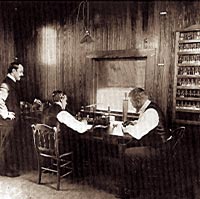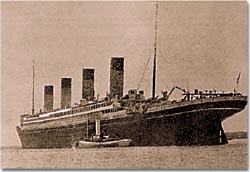Fessenden’s Christmas concert
Last month, we asked what was the content of the first-ever radio broadcast of
voices and music, made by Reginald Aubrey Fessenden in 1906. A clue to the answer
is in the time of the broadcast, on 24 December that year. Not surprisingly, its
content was to do with Christmas!
From a transmitter at Brant Rock in Massachusetts, United States of America,
Fessenden and assistants played Christmas music and gave seasonal readings. The
programme included Fessenden playing the hymn “Oh Holy Night” on the violin, and
singing the final verse. The first-ever listeners to a broadcast were astonished
radio operators on ships at sea, and the programme was heard from the Atlantic to
the Caribbean.
Inspired by the telephone’s inventor
Fessenden was born in Quebec, Canada, in 1866 and was apparently a child prodigy.
At only 14 years old, he was granted a mathematics qualification from a college
in the province. But perhaps one of the most influential events in his life happened
when he was 10: hearing an account by his uncle of attending a demonstration of
the telephone by its inventor, Alexander Graham Bell, who lived in a nearby town.
Bell, of course, was transmitting voices through waves of electricity travelling
along a wire; Fessenden reportedly wondered why the wires were necessary, since
sound waves, for example, can travel long distances without them.

Fessenden (seated right) made the first radio broadcast from this station
at Brant Rock in Massachusetts, United States
Source: North Carolina Office of Archives
and History (Raleigh, NC, United States) |
|
Such early interest eventually led Fessenden to the world of radio, after working
in several other fields, including a spell at Thomas Edison’s laboratory. In 1900,
almost exactly six years to the day before his Christmas broadcast, Fessenden made
the first-ever radio transmission of the human voice. His work was based on the
theory of continuous waves to carry the radio signal, rather than the idea of Guglielmo
Marconi that radio waves had to be generated by creating a series of discontinuous
“sparks.” Initially, Fessenden improved Marconi’s system by inventing the synchronous
rotary spark-gap transmitter, but then went on to develop a machine that could
produce continuous radio waves: a high-frequency (HF) alternator with one terminal
connected to the ground, and the other to a tuned antenna. By November 1906, he
had created an HF alternator that operated in the 50-90 kHz band, with a maximum
output of about 300 watts.
Annus mirabilis: 1906
Yet another first for Fessenden was two-way telegraphy across the Atlantic in
January 1906, using Morse code (Marconi had signalled one-way in 1901). Subsequently,
regular messages, on a frequency of about 88 kHz, were passed between Brant Rock
and a station at Macrihanish on the west coast of Scotland. Fessenden and his colleagues
also began experiments with his new HF alternator to send radio transmissions to
a station in Plymouth, Massachusetts. In November, however, they received an unexpected
report from Scotland. Staff at Macrihanish had clearly heard a conversation between
operators at the Plymouth station as they carried out an experiment: an unintentional
transatlantic radio transmission had been made! A month later on Christmas Eve,
Fessenden made a planned broadcast to boats belonging to the United Fruit Company,
carrying bananas from Puerto Rico. The programme was also heard by other ships,
including those of the US Navy, and Fessenden made another broadcast on New Year’s
Eve.
Although his name has been overshadowed by others (such as Marconi) who were
more adept at promoting their ideas, Fessenden was undoubtedly a genius. By the
time of his death in 1932, he held hundreds of patents — second only in number to
Edison. The continuous-wave radio system he created became the standard for all
future developments, and he also invented many other highly useful technologies,
from radio pagers to a type of microfilm. But perhaps the invention that touches
us most is that of the radio broadcast, bringing distant voices and music directly
to our ears.
Fessenden and the “Titanic”
| |

Marconi corporation
|
The ocean liner Titanic sank on her maiden voyage in 1912, after
colliding with an iceberg in the north Atlantic. The loss of life greatly affected
Fessenden, and he set out to develop a practical way of preventing similar disasters.
Already, he had discovered the principle of sonic frequency echo-sounding. The idea
was for a transducer to be mounted on a ship some 3 metres below the water surface,
from which short bursts of sound would be produced at frequencies of up to 20 kHz.
Fessenden deduced that the sound waves would be able to travel several kilometres,
and would bounce back to the ship off any submerged object in their path. The distance
of the object (or the sea floor) could be determined by timing the return of the
sound. In 1914, the US Navy tested Fessenden’s submarine electric oscillator
in the Atlantic, and found that it could indeed detect icebergs up to 4 kilometres
away. Sound navigation and ranging — more usually known as sonar — was born.
This technique was further developed by Fessenden for use during World War I
to detect submarines at sea. In the 1920s, he also invented a fathometer that became
common equipment on board ships, including cable-laying vessels. His achievements
in promoting safety at sea were highly appreciated; they are also referred to in
an inscription on his grave in Bermuda: “By his genius, distant lands converse and
men sail unafraid on the deep.”
A question to ponder during the New Year holidays:
Where is there an important satellite dish named Arthur after the king in
the “Knights of the Round Table” legends? The answer will be given in the January-February
issue of ITU news. |
|
|


